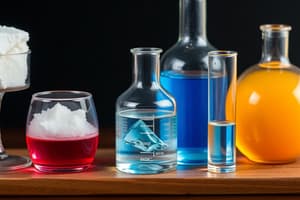Podcast
Questions and Answers
What is the defining property of solids as described in the text?
What is the defining property of solids as described in the text?
- They have indefinite shape and volume
- Their particles move freely and independently
- Their particles are far apart from each other
- Their particles have a fixed position relative to each other (correct)
How do liquids differ from solids in terms of particle movement?
How do liquids differ from solids in terms of particle movement?
- Liquids have particles that vibrate in fixed positions
- Particles in liquids do not move at all
- Solid particles can easily separate and move freely
- Particles in liquids slide past each other while maintaining contact (correct)
Which state of matter has the loosest arrangement of particles?
Which state of matter has the loosest arrangement of particles?
- Plasmas
- Solids
- Liquids
- Gases (correct)
What characteristic allows liquids to take the shape of their container?
What characteristic allows liquids to take the shape of their container?
Which property of solids is responsible for their hardness and rigidity?
Which property of solids is responsible for their hardness and rigidity?
Which state of matter exhibits compressibility only under extreme conditions?
Which state of matter exhibits compressibility only under extreme conditions?
What is the process called when a substance turns from a gas directly to a solid?
What is the process called when a substance turns from a gas directly to a solid?
During which state transition does a substance absorb heat energy?
During which state transition does a substance absorb heat energy?
Which type of matter becomes denser when compressed?
Which type of matter becomes denser when compressed?
What happens during the process of boiling?
What happens during the process of boiling?
Flashcards are hidden until you start studying
Study Notes
Matter Surrounding Us: Understanding States of Matter
Matter is all around us – from the air we breathe to the objects we touch. In its most fundamental form, it's comprised of tiny particles called atoms and molecules. These building blocks behave differently depending on their physical state, known collectively as states of matter. This primer will explore these different forms of matter you encounter daily.
Solids
In solid matter, atoms and molecules pack closely together, forming an ordered structure. Each particle has a fixed position relative to its neighbors. Examples of solids can be found throughout your environment; think steel buildings, glass windows, chairs, tables, and ice cubes. Solid materials possess unique properties like hardness, brittleness, and rigidity due to strong interatomic forces holding their constituents tightly together.
Liquids
Liquids share some characteristics with solids, such as definite volume but indefinite shape. Atoms and molecules in liquids move continually yet remain close enough to one another that they cannot easily separate unless forced apart by external pressure. Common examples of liquid matter include water, oil, mercury, and alcohol. Unlike solids, where the particles have a specific arrangement, those within a liquid slide past each other while maintaining contact. Consequently, liquids take the shape of any container they occupy without breaking apart.
Gases
Gas is the loosest of all three common states of matter. Here, atoms and molecules continuously move rapidly and freely, filling whatever space is available regardless of the size or shape of their container. As gases expand to fill available space, their volume increases significantly, but their mass remains constant. Air, steam, and natural gas are typical examples of gaseous matter. Gas density varies considerably compared to solids and liquids because individual particles are far less concentrated. In contrast to solids and liquids, which exhibit compressibility only under extreme conditions, gases become denser when compressed, making them easier to store and transport.
State Transitions
States of matter can change through processes like melting, boiling, condensation, evaporation, and sublimation. When a solid turns into a liquid via melting, it absorbs heat energy, allowing the particles to overcome the attractive forces between them. Boiling occurs when a substance heats up further until its vapor pressure equals atmospheric pressure, causing some of the liquid to turn into gas. A reversal of this process happens during condensation, illustrating how transitions often occur due to temperature changes. Sublimation is a more complex process involving convertion directly from a solid phase to a gas phase without becoming a liquid first.
Understanding these key concepts allows you to better appreciate the nature and behavior of everyday matter surrounding you.
Studying That Suits You
Use AI to generate personalized quizzes and flashcards to suit your learning preferences.




